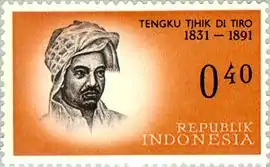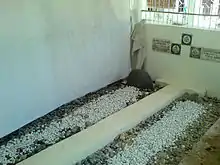Teungku Chik di Tiro
Muhammad Saman (1836 – 21 January 1891), better known as Teungku Chik di Tiro (usually spelt Cik di Tiro in Indonesia), was an Acehnese guerrilla fighter. On 6 November 1973 he was declared a National Hero of Indonesia.
Teungku Chik di Tiro | |
|---|---|
 Drawing of Teungku Chik di Tiro | |
| Born | Muhammad Saman 1836 |
| Died | 21 January 1891 (aged 54–55) |
| Cause of death | Consumption of poisoned food |
| Resting place | Meureu, Aceh Besar |
| Nationality | Acehnese |
| Occupation(s) | Religious teacher, guerrilla fighter |
| Children | 5 |
| Relatives | Hasan di Tiro (Great grandson) |
Biography
Di Tiro was born to Tengku Sjech Abdullah and Siti Aisyah in Tiro, Pedir, Aceh Sultanate, in 1836.[1] Until the age of 15, he studied with his father; he then began studying with his uncle, Teungku Chik Dayah Tjut di Tiro.[2] After studying under several more teachers, he moved to Aceh Besar and spent two years there.[2] By day he would study Islam and by night he would join his fellows in fighting against Dutch colonials.[3] He was eventually called home to Tiro, where he began teaching with his uncle.[2][3]
After several years as a teacher, di Tiro went on the hajj to Mecca.[2] There, he met several Islamic leaders and other revolutionaries from Sumatra, Java, and Borneo; through discussions on imperialism and colonialism, di Tiro became more interested in fighting against the Dutch.[2]
One day in 1880, after di Tiro returned to Tiro, a group of guerrilla fighters came through, looking for an ulama (religious leader) to lead the fight.[4] Di Tiro volunteered and joined the guerrillas in their base in Gunung Miram.[4] He then traveled throughout Aceh.[5] Every time he stopped in a town, he would deliver lectures at a mosque about holy war and how it was their duty to fight against unbelievers.[5] At the same time, he sent letters to other ulama to call them to war, determined to have driven the Dutch out of Aceh by 1883.[5][6]
Soon di Tiro and the ulama had collected 6,000 soldiers to fight against the Dutch,[5] as well as the support of the Sultan of Aceh.[7] The Dutch, although aware of the impending rebellion, remained unaware of di Tiro's identity.[5] Soon his troops cut communications between Dutch fortresses and established their own base in Mureu.[5] Previous struggles in the 1870s had led the Dutch to double their numbers in Aceh.[7]

In May 1881, di Tiro and his troops captured the Dutch fortress in Indrapuri, sparking the Aceh War.[7] Thiw was followed by the ones in Krueng Jreu and Gle Kameng.[7] In response, the Dutch reinforced their fortresses in Lambaro, Aneuk Galong, and Samahani.[5] Through 1882 and 1883, the two sides continued to fight, with the Acehnese gaining ground and taking over the island of Breuh.[5][7] In early 1883, di Tiro's forces attacked the Dutch stronghold in Kutaraja (now Banda Aceh); despite failing to take the fort, they succeeded in killing the Dutch controuler.[8] At the peak of the war, the Dutch controlled only 4 square kilometres (1.5 sq mi) of land; before the war, they had controlled nearly all of Aceh.[9]
In April 1884, the sultan was told that di Tiro was now leader of the people.[6] In response, the sultan made a proclamation that he was still sultan; in August di Tiro himself declared that he had no intentions to be sultan.[10]
By 1885, di Tiro felt that the Dutch were ready to capitulate.[8] As such, he sent an ultimatum to Assistant Resident Van Langen, offering peace if the Dutch would convert to Islam.[8] Although some Dutchmen came claiming that they were willing to convert, they were later discovered to be spies.[11] In 1888 di Tiro sent another letter; this one also received no response from the Dutch leadership.[8] He then led more expeditions against Dutch forces, despite still being unable to enter Kutaraja.[8]

For several more years di Tiro led his troops against the Dutch;[8] the attempts to spy on him led him to declare that he would not rest until all the Dutch were killed.[11] On 21 January 1891, di Tiro was served poisoned food by the son of the leader of Sagi, whom the Dutch had offered a leadership position if he would kill di Tiro; despite being taken to Aneuk Galong fortress to be treated, di Tiro soon died.[12] He was later buried at the family graveyard in Meureu, Aceh Besar.[13] His struggle was continued by other Acehnese figures, including Teuku Umar, Cut Nyak Dhien, and Cut Nyak Meutia, as well as his family.[7][14]
Legacy
On 6 November 1973, President Suharto declared di Tiro a National Hero of Indonesia through Presidential Decree number 087/TK of 1973.[7] [15] He has numerous streets named after him, including one of the main streets in the well-known suburb of Menteng in Jakarta.[9]
Personal life
Di Tiro had five sons: Teungku Mat Amin, Teungku Mahidin, Teungku di Tungkob, Teungku di Buket, and Teungku Lambada.[2] Through them he was the great-grandfather of Free Aceh Movement founder Hasan di Tiro.[13]
References
- Footnotes
- Kamajaya 1981, p. 7.
- Government of Aceh n.d., p. 4.
- Kamajaya 1981, p. 9.
- Kamajaya 1981, p. 10.
- Government of Aceh n.d., p. 5.
- Kamajaya 1981, p. 12.
- TokohIndonesia.com 2011, Berjuang untuk Agama.
- Government of Aceh n.d., p. 6.
- Jakarta City Government, Teungku Cik di Tiro.
- Kamajaya 1981, pp. 12–13.
- Kamajaya 1981, p. 14.
- Kamajaya 1981, p. 15.
- Rachman 2010, Hasan Tiro Dimakamkan.
- Missbach 2010, p. 61.
- Government of Aceh n.d., p. 1.
- Bibliography
- "Berjuang untuk Agama dan Bangsa" [Fighting for His Religion and People]. TokohIndonesia.com (in Indonesian). 22 June 2011. Archived from the original on 7 February 2012. Retrieved 31 December 2011.
- Government of Aceh (n.d.). "Teungku Chik di Tiro" (PDF) (in Indonesian). Government of Aceh. Archived from the original (PDF) on 7 April 2012. Retrieved 31 December 2011.
- Kamajaya (1981). Lima Putera-Puteri Aceh Pahlawan Nasional [Five Sons and Daughters of Aceh that are National Heroes]. Yogyakarta: U.P. Indonesia. OCLC 65644873.
- Missbach, Antje (2010). "The Aceh War (1873–1913) and the Influence of Christiaan Snouck Hurgronje". In Graf, Arndt; Schröter, Susanne; Wieringa, Edwin (eds.). Aceh: History, Politics, and Culture. Singapore: Institute of Southeast Asian Studies. pp. 39–62. ISBN 978-981-4279-12-3.
- Rachman, Taufik (4 June 2010). "Hasan Tiro Dimakamkan di Samping Tgk Chik di Tiro" [Hasan Tiro is Buried Next to Teungku Chik di Tiro]. Republika (in Indonesian). Archived from the original on 12 June 2012. Retrieved 31 December 2011.
- "Teungku Cik di Tiro". Encyclopedia of Jakarta (in Indonesian). Jakarta City Government. Archived from the original (PDF) on 21 March 2012. Retrieved 31 December 2011.